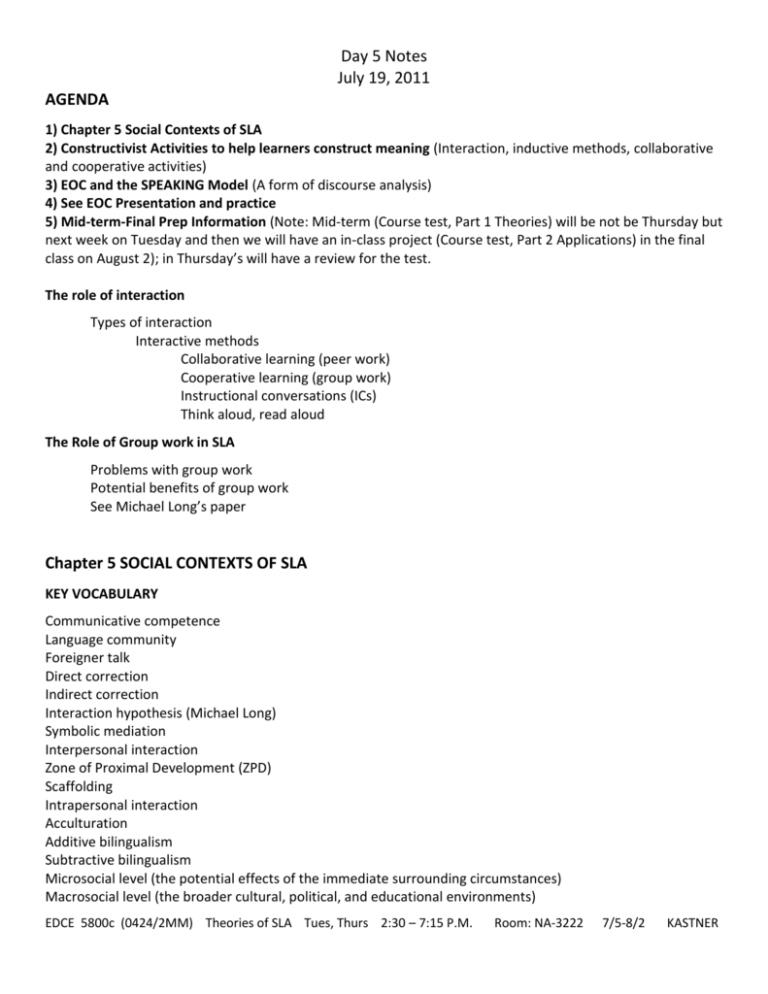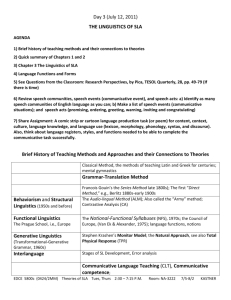Chapter 5 SOCIAL CONTEXTS OF SLA
advertisement

Day 5 Notes July 19, 2011 AGENDA 1) Chapter 5 Social Contexts of SLA 2) Constructivist Activities to help learners construct meaning (Interaction, inductive methods, collaborative and cooperative activities) 3) EOC and the SPEAKING Model (A form of discourse analysis) 4) See EOC Presentation and practice 5) Mid-term-Final Prep Information (Note: Mid-term (Course test, Part 1 Theories) will be not be Thursday but next week on Tuesday and then we will have an in-class project (Course test, Part 2 Applications) in the final class on August 2); in Thursday’s will have a review for the test. The role of interaction Types of interaction Interactive methods Collaborative learning (peer work) Cooperative learning (group work) Instructional conversations (ICs) Think aloud, read aloud The Role of Group work in SLA Problems with group work Potential benefits of group work See Michael Long’s paper Chapter 5 SOCIAL CONTEXTS OF SLA KEY VOCABULARY Communicative competence Language community Foreigner talk Direct correction Indirect correction Interaction hypothesis (Michael Long) Symbolic mediation Interpersonal interaction Zone of Proximal Development (ZPD) Scaffolding Intrapersonal interaction Acculturation Additive bilingualism Subtractive bilingualism Microsocial level (the potential effects of the immediate surrounding circumstances) Macrosocial level (the broader cultural, political, and educational environments) EDCE 5800c (0424/2MM) Theories of SLA Tues, Thurs 2:30 – 7:15 P.M. Room: NA-3222 7/5-8/2 KASTNER What must L2 learners know and be able to do in order to communicate effectively? Communicative Competence (Dell Hymes) Ethnography of Communication (EOC) and the SPEAKING Model (a kind of discourse analysis) Language community , speech event (communicative event), speech act (utterance), language functions Microsocial Factors Social contexts for SLA vary greatly SES is important L2 variation Variation in Learner Language Communicative contexts: Input and Interaction Input to intake Comprehensible input Nature of Input Modifications Foreigner talk (modification of input) speech from L1 speakers to L2 learners that differs in systematic ways from language addressed to native or very fluent speakers Accommodation Theory: Interactional modification Speech and written modifications Scaffolding EDCE 5800c (0424/2MM) Theories of SLA Tues, Thurs 2:30 – 7:15 P.M. Room: NA-3222 7/5-8/2 KASTNER Feedback Direct correction Indirect correct Intake to Cognitive Processing The Interaction Hypothesis (Michael Long) Interaction as the Genesis of Language Sociocultural (S-C) Theory Constructivism EDCE 5800c (0424/2MM) Theories of SLA Tues, Thurs 2:30 – 7:15 P.M. Room: NA-3222 7/5-8/2 KASTNER A key concept in this approach is that interaction not only facilitates language learning but is a causative force in acquisition. Symbolic mediation: a link between a person’s current mental state and higher order functions that is provided primarily by language. Vygotsky pointed out two main ways language is used as a tool by humans: 1) Interpersonal interaction: Language for others, i.e., the social use of language, and 2) Intrapersonal interaction: language for self as a tool for personal use and mental operations. He viewed language as first for others and secondly for personal use, and that learning language follows a similar course. Private speech, i.e., self-talk which many children engage in that leads to inner speech. Private speech and private writing, i.e., voice (internalizing language use) Interpersonal Interaction Children learn in communities and through communicative events Zone of Proximal Development (ZPD): One important context for symbolic mediation is interpersonal interaction between learners and “experts” (experts include teachers and more knowledgeable learners). Scaffolding Intersubjectivity Acquisition without interaction; interaction without acquisition Other strategies are used for communication: Background knowledge and experience which help individuals organize new information and make guesses about what is going on and what will happen next Understanding of the overall situation or event, including its goal, the relationships among participants, and what they expect one another to say and do Extralinguistic context, including physical setting and objects Knowledge of genre-specific discourse structures: e.g., what rules for interaction are expected in a conversation versus a lesson at school, and what sequence of actions is likely Gestures, facial expressions, and other non-verbal signs Prosodic features of tone and stress to convey emotional state Macrosocial Factors Ethnography of Communication (EOC) and Social Psychology Identity, status, and values Global and national statuse of L1 and L2 Boundaries and identities EDCE 5800c (0424/2MM) Theories of SLA Tues, Thurs 2:30 – 7:15 P.M. Room: NA-3222 7/5-8/2 KASTNER Institutional forces and constraints Social categories Circumstances of learning Global and National Status of L1 and L2 Languages have power and status at global and national levels for both symbolic and practical reasons. Political identification and cohesion Nation building and conquest Economic and political benefits Boundaries and Identities Full participation often requires learning the culture of that community and adapting to those values and behavioral patterns, i.e., acculturation. Whether that occurs depends largely on group motivation. Acculturation Model, John Schumann Acculturation Social distance Perceived social distance Optimal social distance Institutional Forces and Constraints Social institutions are systems which are established by law, custom, or practice to regulate and organize the life of people in public domains, e.g., politics, religion, and education. Many of these involve power, authority, and influence related to SLA (social control, determination of access to knowledge, and other instances of privilege or discrimination. Social Categories For examples, age, sex, ethnicity, education level, occupation, and economic status (socioeconomic status) For example, different learning conditions for males and females, casts Other Ideas: Culture shock model/theory EOC and the SPEAKING Model Some Conclusions for the course Four major influences that affect teaching SLA: Cognitive (information processing), Constructivist, and EOC Two major systems in acquisition: 1) Grammatical/Conventional and 2) Pragmatic Still no laws (but many theories and hypotheses) Chapter 6 Review Communicative competence review EDCE 5800c (0424/2MM) Theories of SLA Tues, Thurs 2:30 – 7:15 P.M. Room: NA-3222 7/5-8/2 KASTNER Review for Part 1 of Course Test Cognitive/ Information Processing (IP) Sociocultural (S-C) Theory Ethnography of Communication (EOC) Innate Linguistic Perspectives The roles of cognition and information processing Processability The role of affective factors Input to intake Output Task-based Learning Content-based learning Academic competence Strategies-based instruction (SBI) Learning strategies Metacognitive, Cognitive, Communicative, Socioaffective, and Task-based strategies (reading, writing, speaking, listening strategies) Learning styles Interlanguage (IL) Stages of language development Connectionism Parallel Distributed Processing (PDP) Language transfer, negative transfer (interference) Error analysis(EA) Declarative and procedural knowledge Schema theory Top-down and bottom-up processing Constructivism Constructing meaning Social interaction Scaffolding Zone of Proximal Development (ZPD) Symbolic mediation Inner speech/self-talk Collaborative/ Cooperative learning (group work) socialization Discourse analysis Speech communities, speech events (communicative situations), speech acts (utterances) Language functions registers Pragmatic competence The SPEAKING Model Communicative competence Interpersonal competence Pragmatic competence Inner speech (self-talk or private speech) Innate capacity Language Acquisition Device (LAD) Language Universals (e.g., Universal grammar, UG) = Principals and parameters The role of input (e.g., comprehensible input) Competence vs. performance Natural order of acquisition Critical period hypothesis Interlanguage (IL) Acquisition vs. learning See Krashen’s five major hypotheses The silent period *HONORABLE MENTION: Behaviorism has made several significant contributions to learning and second language learning, e.g., S-R conditioning, operant conditioning, reinforcement, contrastive analysis (CA), etc. Other Important Concepts and Terms Structural Linguistics (Structuralism) Transformational-generative (Generative) Linguistics Functional Linguistics (Functionalism) Neurolinguistic Corpus linguistics Sociolinguistics Behaviorism Cognitive Psychology Constructivism EDCE 5800c (0424/2MM) Theories of SLA Tues, Thurs 2:30 – 7:15 P.M. Room: NA-3222 7/5-8/2 KASTNER Grammar-translation method Communicative language teaching (CLT) TPR Natural Learning (from Stephen Krashen’s Monitor Model) Eclecticism CALLA Task-based learning Strategies-based instruction SIOP QTEL Inquiry-based learning BICS CALP Contextualization (context-reduced and context-embedded input/instruction) Modeling Restructuring Cognitive dissonance SIFE EDCE 5800c (0424/2MM) Theories of SLA Tues, Thurs 2:30 – 7:15 P.M. Room: NA-3222 7/5-8/2 KASTNER










